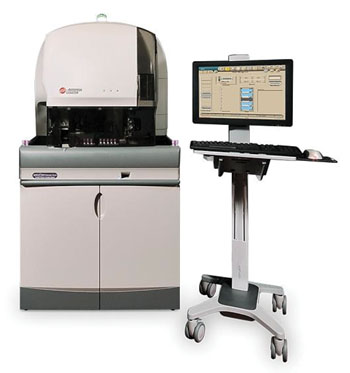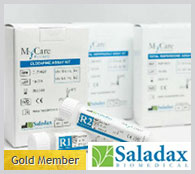Automated Slidemaker-Stainer Evaluated for Performance
|
By LabMedica International staff writers Posted on 01 May 2014 |

Image: UniCel DxH Slidemaker Stainer Coulter Cellular Analysis System (Photo courtesy of Beckman Coulter).
Although there have been advancements in instrumentation within hematology laboratories, there is still a need for review of a peripheral blood films (PBF).
Morphological assessment is extremely subjective and dependent on the acceptable standard of the film being assessed, and it is important to determine whether or not automated slidemaker-stainers are able to consistently and reproducibly prepare and stain blood films of exemplary quality, without carryover between specimens.
Hematologists at the London Health Sciences Center (London, ON, Canada) selected a total of 131 specimens, 46 morphologically normal and 85 hematologically abnormal, from their Health Center which specializes in cancer care, pediatrics, and obstetrics. A broad specimen pool of potential disease states was recruited from the day-to-day workload over an eight-day period. Four blood films were prepared manually and stained with the laboratory's routine method of Wright-Giemsa.
The scientists evaluated the UniCel DxH slidemaker stainer (DxH SMS, Beckman Coulter; Brea, CA, USA) which is a fully automated, integrated slidemaker, and stainer intended for the hematology laboratory. The DxH SMS is available either as a stand-alone instrument or part of the DxH workcell configuration. A unique patented device, the hemasphere, is incorporated into the system to measure “residual clinging” of the blood sample to an internal surface as an analogue for the way in which blood would behave as it is spread on a glass slide. Two samples were selected to perform this study evaluating the degree of cellular carryover that has the potential to occur in circumstances when a sample with extreme leukocytosis is followed by one with extreme leukopenia.
The investigators found that carryover was not an issue and repeatability was within expected limits. There was excellent agreement of the five-part differential between the automated blood films made by the DxH-SMS compared with the manually prepared reference blood film. There was no difference in identification and enumeration of blasts, variant lymphocytes, or nucleated red blood cells and red cell morphology showed excellent agreement.
The authors concluded that blood films prepared by the DxH-SMS are of excellent quality, the required cleaning requirements are simple, the software is intuitive, and the burden of quality related to the reagents is carried by the manufacturer. All of these reasons led them to believe they have made the right choice in incorporating the slidemaker/stainer into the configuration of their clinical instrumentation. The study was published in the April 2014 issue of International Journal of Laboratory Hematology.
Related Links:
London Health Sciences Center
Beckman Coulter
Morphological assessment is extremely subjective and dependent on the acceptable standard of the film being assessed, and it is important to determine whether or not automated slidemaker-stainers are able to consistently and reproducibly prepare and stain blood films of exemplary quality, without carryover between specimens.
Hematologists at the London Health Sciences Center (London, ON, Canada) selected a total of 131 specimens, 46 morphologically normal and 85 hematologically abnormal, from their Health Center which specializes in cancer care, pediatrics, and obstetrics. A broad specimen pool of potential disease states was recruited from the day-to-day workload over an eight-day period. Four blood films were prepared manually and stained with the laboratory's routine method of Wright-Giemsa.
The scientists evaluated the UniCel DxH slidemaker stainer (DxH SMS, Beckman Coulter; Brea, CA, USA) which is a fully automated, integrated slidemaker, and stainer intended for the hematology laboratory. The DxH SMS is available either as a stand-alone instrument or part of the DxH workcell configuration. A unique patented device, the hemasphere, is incorporated into the system to measure “residual clinging” of the blood sample to an internal surface as an analogue for the way in which blood would behave as it is spread on a glass slide. Two samples were selected to perform this study evaluating the degree of cellular carryover that has the potential to occur in circumstances when a sample with extreme leukocytosis is followed by one with extreme leukopenia.
The investigators found that carryover was not an issue and repeatability was within expected limits. There was excellent agreement of the five-part differential between the automated blood films made by the DxH-SMS compared with the manually prepared reference blood film. There was no difference in identification and enumeration of blasts, variant lymphocytes, or nucleated red blood cells and red cell morphology showed excellent agreement.
The authors concluded that blood films prepared by the DxH-SMS are of excellent quality, the required cleaning requirements are simple, the software is intuitive, and the burden of quality related to the reagents is carried by the manufacturer. All of these reasons led them to believe they have made the right choice in incorporating the slidemaker/stainer into the configuration of their clinical instrumentation. The study was published in the April 2014 issue of International Journal of Laboratory Hematology.
Related Links:
London Health Sciences Center
Beckman Coulter
Latest Hematology News
- Next Gen CBC and Sepsis Diagnostic System Targets Faster, Earlier, Easier Results
- Newly Discovered Blood Group System to Help Identify and Treat Rare Patients
- Blood Platelet Score Detects Previously Unmeasured Risk of Heart Attack and Stroke
- Automated Benchtop System to Bring Blood Testing To Anyone, Anywhere
- New Hematology Analyzers Deliver Combined ESR and CBC/DIFF Results in 60 Seconds
- Next Generation Instrument Screens for Hemoglobin Disorders in Newborns
- First 4-in-1 Nucleic Acid Test for Arbovirus Screening to Reduce Risk of Transfusion-Transmitted Infections
- POC Finger-Prick Blood Test Determines Risk of Neutropenic Sepsis in Patients Undergoing Chemotherapy
- First Affordable and Rapid Test for Beta Thalassemia Demonstrates 99% Diagnostic Accuracy
- Handheld White Blood Cell Tracker to Enable Rapid Testing For Infections
- Smart Palm-size Optofluidic Hematology Analyzer Enables POCT of Patients’ Blood Cells
- Automated Hematology Platform Offers High Throughput Analytical Performance
- New Tool Analyzes Blood Platelets Faster, Easily and Accurately
- First Rapid-Result Hematology Analyzer Reports Measures of Infection and Severity at POC
- Bleeding Risk Diagnostic Test to Reduce Preventable Complications in Hospitals
- True POC Hematology Analyzer with Direct Capillary Sampling Enhances Ease-of-Use and Testing Throughput
Channels
Clinical Chemistry
view channel.jpg)
POC Saliva Testing Device Predicts Heart Failure in 15 Minutes
Heart failure is a serious condition where the heart muscle is unable to pump sufficient oxygen-rich blood throughout the body. It ranks as a major cause of death globally and is particularly fatal for... Read more
Screening Tool Detects Multiple Health Conditions from Single Blood Drop
Infrared spectroscopy, a method using infrared light to study the molecular composition of substances, has been a foundational tool in chemistry for decades, functioning similarly to a molecular fingerprinting... Read more
Integrated Chemistry and Immunoassay Analyzer with Extensive Assay Menu Offers Flexibility, Scalability and Data Commutability
As global healthcare systems increasingly shift towards networked laboratory operational models to enhance efficiency and patient access, there is a greater need for innovative solutions tailored to the... Read moreMolecular Diagnostics
view channel
Respiratory Panel to Help Clinicians Make Precise Treatment Decisions in Outpatient Settings
Respiratory tract infections are the primary reason for visits to emergency departments and subsequent hospitalizations. In the U.S., it is estimated that there are up to 41 million cases of influenza... Read more
Integrating Cardiovascular Risk Biomarkers Aids in Detection of ‘Inflammaging’
Cardiovascular diseases (CVD) continue to be the leading cause of death globally, responsible for nearly one-third of all fatalities worldwide. Traditionally, risk assessment for CVD has focused on well-established... Read more
Genetic Signature in Newborns Predicts Neonatal Sepsis Before Symptoms Appear
Neonatal sepsis, which occurs due to the body’s abnormal response to severe infection within the first 28 days of life, results in approximately 200,000 deaths globally each year. This condition affects around 1.... Read more.jpeg)
Integrating Multiple Protein Markers Predicts Health Outcomes in Chronic Kidney Disease Patients
Previous attempts to discover novel kidney biomarkers as risk factors for chronic kidney disease (CKD) progression have generally focused on evaluating proteins individually, which limits their prognostic... Read moreImmunology
view channel
Computational Tool Predicts Immunotherapy Outcomes for Metastatic Breast Cancer Patients
Immunotherapy aims to enhance the body’s immune response to target cancer cells, but not all patients experience a positive reaction to such treatments. Identifying which patients will benefit from immunotherapy... Read more
Biomarker Could Predict Immunotherapy Response in Liver Cancer
Until recently, patients diagnosed with hepatocellular carcinoma had limited treatment options, with existing therapies extending life by only a few months. Immunotherapy has emerged as a new alternative... Read more
Epigenetic Test Could Determine Efficacy of New Immunotherapy Treatments Against Multiple Myeloma
Multiple myeloma is a blood cancer that primarily affects individuals over the age of sixty, and its occurrence rises as the population ages. In this disease, the bone marrow—the spongy tissue inside bones... Read moreMicrobiology
view channel
High-Accuracy Bedside Test to Diagnose Periprosthetic Joint Infection in Five Minutes
Periprosthetic joint infection (PJI) represents a significant global issue that is worsening as the number of joint replacements increases due to aging populations. In the United States alone, the anticipated... Read more_1.jpg)
Innovative Diagnostic Approach for Bacterial Infections to Enable Faster and Effective Treatment
For patients with bacterial infections, timely treatment with the appropriate antibiotics significantly improves their chances of recovery. Current methods for identifying which antibiotics will be effective... Read more
Non-Invasive Stool Test to Diagnose Endometriosis and Help Reduce Disease Progression
Endometriosis, a painful condition impacting nearly 200 million women globally, occurs when tissue similar to the lining of the uterus grows outside its usual location, such as on the intestines or the... Read more
Automated Positive Blood Culture Sample Preparation Platform Designed to Fight Against Sepsis and AMR
Delayed administration of antibiotics to patients with bloodstream infections significantly increases the risk of morbidity and mortality. For optimal therapeutic outcomes, it is crucial to rapidly identify... Read morePathology
view channel
New Imaging Method Opens Door to Precision Diagnostics for Head and Neck Cancers
Head and neck cancers, while considered rare, represent a significant portion of cancer cases and have seen a notable increase over the past 30 years. These cancers encompass various malignant tumors that... Read more
Faster Measurement of Vibrational Fingerprint of Molecules to Advance Biomedical Diagnostics
Identifying different types of molecules and cells is a vital process in both basic and applied science. Raman spectroscopy serves as a widely utilized measurement technique for this purpose.... Read moreTechnology
view channel
New Noninvasive Methods Detect Lead Exposure Faster, Easier and More Accurately at POC
Exposure to lead can negatively affect health in multiple ways, leading to damage in the brain and central nervous system, delays in development and growth, learning and behavioral issues, problems with... Read more
Noninvasive Test Detects Malaria Without Blood Sample
Malaria remains a significant global health issue, with approximately 250 million cases and over 600,000 deaths reported annually. Nearly half of the world's population is at risk for malaria infection,... Read moreIndustry
view channel
Beckman Coulter Partners with BioPorto for Global Distribution of Acute Kidney Injury NGAL Tests
Acute kidney injury (AKI) is a sudden episode of kidney failure or damage that can occur within a few hours or days. This condition leads to the accumulation of waste products in the blood and disrupts... Read more_1.jpg)
CACLP 2025 New Date and Venue Announced
The 22nd China International In Vitro Diagnostic Expo, organized by the China Association of Clinical Laboratory Practice Expo (CACLP, Shanghai, China), is set to take place from March 21 to 24, 2025,... Read more
Roche to Develop New Diagnostic Technologies for Traumatic Brain Injuries
Traumatic brain injuries (TBI) represent a significant global health issue, affecting approximately 69 million people each year. TBI occurs when an external force disrupts normal brain function, with severity... Read more















